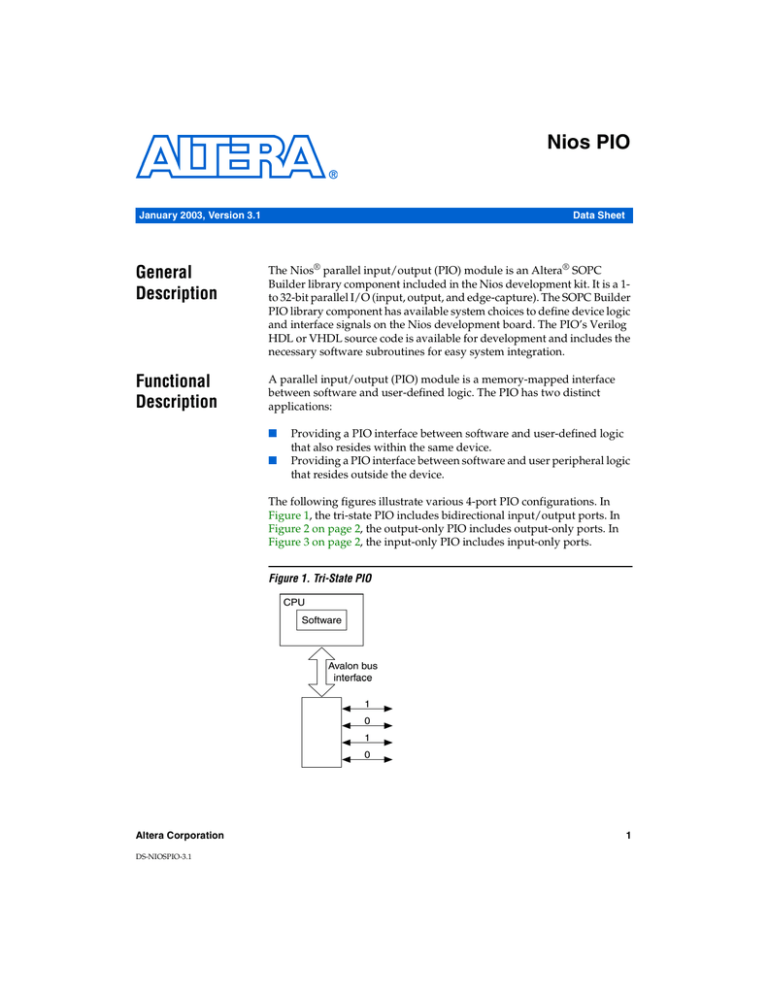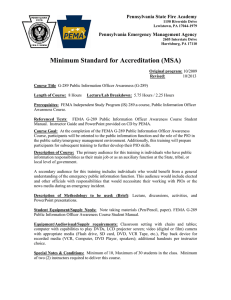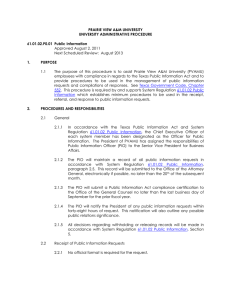
Nios PIO
January 2003, Version 3.1
Data Sheet
General
Description
The Nios® parallel input/output (PIO) module is an Altera® SOPC
Builder library component included in the Nios development kit. It is a 1to 32-bit parallel I/O (input, output, and edge-capture). The SOPC Builder
PIO library component has available system choices to define device logic
and interface signals on the Nios development board. The PIO’s Verilog
HDL or VHDL source code is available for development and includes the
necessary software subroutines for easy system integration.
Functional
Description
A parallel input/output (PIO) module is a memory-mapped interface
between software and user-defined logic. The PIO has two distinct
applications:
■
■
Providing a PIO interface between software and user-defined logic
that also resides within the same device.
Providing a PIO interface between software and user peripheral logic
that resides outside the device.
The following figures illustrate various 4-port PIO configurations. In
Figure 1, the tri-state PIO includes bidirectional input/output ports. In
Figure 2 on page 2, the output-only PIO includes output-only ports. In
Figure 3 on page 2, the input-only PIO includes input-only ports.
Figure 1. Tri-State PIO
Altera Corporation
DS-NIOSPIO-3.1
1
Nios PIO Data Sheet
Figure 2. Output-Only PIO
Figure 3. Input-Only PIO
2
Altera Corporation
Nios PIO Data Sheet
Table 1 lists and describes the PIO registers.
PIO Registers
Table 1. PIO Register Map
A1..A0
0
Register Name
R/W
data
read
RO
Data value currently on PIO inputs
Variable Size—1 to 32 bits
write
WO
New value to drive on PIO outputs
1
direction
RW
Data direction (optional): Individual control for each PIO bit
2
interruptmask
RW
Interrupt mask (optional): Per-bit IRQ enable/disable
3
edgecapture1
RW
Edge capture (optional): Per-bit synchronous edge detect and hold
Note
(1)
A write operation to the edgecapture register clears all bits in register 0.
data Register
For an input-only PIO (when the PTF parameters has_out and has_tri
are both set to 0), writing to the data register has no effect. For an outputonly PIO (when has_in and has_tri are both set to 0), reading from the
data register produces an undefined result.
direction Register
When the PTF parameter has_tri is set to 1, both the PIO’s input ports
and output ports connect to one pin with tri-state control on the device.
The direction register controls the data direction for each PIO bit.
When direction is set to 1, the corresponding PIO port’s data direction
is out. When direction is set to 0, the data direction is in.
At system reset, all direction register bits are set to 0. When has_tri
is 0, this register does not exist. For details, see “has_tri” on page 6.
interruptmask Register
When a bit in the interruptmask register is set to 1, interrupts are
enabled for the corresponding PIO port. The PTF parameter irq_type
determines how interrupts are generated based on PIO inputs. For details,
see “irq_type” on page 7. If the PTF setting irq_type is NONE, this
register does not exist, because there are no interrupts to enable.
At system reset, the interruptmask register is all zeros, and interrupts
are disabled for all PIO ports.
Altera Corporation
3
Nios PIO Data Sheet
edgecapture Register
If the PTF parameter edge_type is set to RISING, FALLING, or ANY, the
edgecapture register sets a bit to 1 to indicate when an edge was
detected on the corresponding PIO input port. The edgecapture
register’s behavior depends on the edge_type value. For details, see
“edge_type” on page 7. If edge_type is set to NONE, the edgecapture
register does not exist.
A write operation to the edgecapture register clears all bits in the data
register.
Software Data
Structure
typedef volatile struct
{
int np_piodata;
int np_piodirection;
}
//
//
//
int np_piointerruptmask; //
//
int np_pioedgecapture;
//
//
np_pio;
read/write, up to 32 bits
write/readable, up to 32 bits,
1->output bit
write/readable, up to 32 bits,
1->enable interrupt
read, up to 32 bits,
cleared by any write
Figure 4. Example: Direct access to PIO
void TurnOnLEDs(void)
{
// the reference design has a PIO named na_led_pio
// that controls two LEDs on the development board
na_led_pio->np_piodirection = 3; // Set direction: output
na_led_pio->np_piodata = 0;
// both LEDs off
nr_delay(1000);
// wait 1 second
na_led_pio->np_piodata = 1;
// turn on first led
nr_delay(1000);
// wait 1 second
na_led_pio->np_piodata = 3;
// both LEDs on
}
4
Altera Corporation
Nios PIO Data Sheet
Software
Subroutine
The nr_pio_showhex subroutine is available in the Nios library (lib
folder in the custom SDK) when one or more PIO peripherals are present
in the Nios system. This function is declared in the include file nios.h.
nr_pio_showhex
This subroutine assumes a 16-bit wide PIO named na_seven_seg_pio
is attached to a two-digit seven-segment display, in which segments are
illuminated when the corresponding bits are set to 0. PIO bits are assigned
to the seven-segment display elements as shown in Figure 5:
Figure 5. Dual Seven-Segment Display
Syntax
void nr_pio_showhex(int value);
Parameter
The value parameter indicates the data to be sent to the seven-segment
display.
Example
#include "nios.h"
void main(void)
{
int c;
printf("Please enter a character:\n");
while((c = nr_uart_rxchar(0)) == -1); // wait for valid input
nr_pio_showhex(c);
printf("Your character is:\t%c, in hex:0x%2x\m", c, c);
}
Altera Corporation
5
Nios PIO Data Sheet
PTF
Assignments
Table 2 lists the PIO’s PTF parameters. Detailed descriptions follow the
table.
Table 2. PIO PTF Parameters
Parameter
Section(1)
Type
Allowed Values
Default
has_tri
M/WSA
Boolean
1, 0
0
has_in
M/WSA
Boolean
1, 0
0
has_out
M/WSA
Boolean
1, 0
1
irq_type
M/WSA
String
NONE, LEVEL, EDGE
NONE
edge_type
M/WSA
String
NONE, RISING, FALLING,
ANY
NONE
Data_Width
M/SBI
Integer
1 .. 32
8
Note
(1)
The Section column describes the parameter’s location in the PTF:
M/WSA = MODULE/WIZARD_SCRIPT_ARGUMENTS
M/SBI = MODULE/SYSTEM_BUILDER_INFO
has_tri
When has_tri is set to 1, the PIO has combined bidirectional
input/output ports instead of separate input ports and separate output
ports.
has_in
When has_in is set to 1, the specified number of separate input signals
are available.
has_out
When has_out is set to 1, the specified number of separate output signals
are available.
1
has_in and has_out can both be set to 1 at the same time to
allow for separate input and output signals. For example, if
Data_Width = 4, has_in = 1, and has_out = 1, a peripheral
with eight I/O ports is created: four dedicated input and four
dedicated output.
If has_tri is set to 1, both the has_in and has_out values are
ignored.
6
Altera Corporation
Nios PIO Data Sheet
irq_type
The irq_type assignment specifies when an interrupt request is
generated. The irq_type values are shown in Table 3:
Table 3. irq_type Values
Value
Description
LEVEL
Generate an interrupt when a PIO input logic level is detected.
EDGE
Generate an interrupt when a PIO input logic level transition is
detected. This value can only be used if the edge_type parameter
is set to RISING, FALLING, or ANY.
NONE
The PIO does not generate an interrupt; the interruptmask register
does not exist.
When irq_type is set to LEVEL or EDGE, the PIO includes both an IRQ
pin to the system and the internal interruptmask register.
edge_type
The edge_type assignment specifies the transition type to be detected in
the edgecapture register during an input to the PIO (see “edgecapture
Register” on page 4). The allowed edge_type values are shown in
Table 4:
Table 4. edge_type Values
Value
RISING
Description
Detect the transition from logical 0 to logical 1.
FALLING Detect the transition from logical 1 to logical 0.
ANY
NONE
Detect any logic level transition.
Detect only the logic level; the edgecapture register does not exist.
Data_Width
The Data_Width assignment specifies the number of bits in the PIO
register. If the has_tri parameter is set to 0, the Data_Width
assignment allows between 1 and 32 input ports and between 1 and 32
output ports. If has_tri is set to 1, the Data_Width assignment allows
a bidirectional interface.
Altera Corporation
7
Nios PIO Data Sheet
101 Innovation Drive
San Jose, CA 95134
(408) 544-7000
http://www.altera.com
Applications Hotline:
(800) 800-EPLD
Literature Services:
lit_req@altera.com
8
Copyright © 2003 Altera Corporation. All rights reserved. Altera, The Programmable Solutions Company, the
stylized Altera logo, specific device designations, and all other words and logos that are identified as
trademarks and/or service marks are, unless noted otherwise, the trademarks and service marks of Altera
Corporation in the U.S. and other countries. All other product or service names are the property of their
respective holders. Altera products are protected under numerous U.S. and foreign patents and pending
applications, mask work rights, and copyrights. Altera warrants performance of its
semiconductor products to current specifications in accordance with Altera’s standard
warranty, but reserves the right to make changes to any products and services at any time
without notice. Altera assumes no responsibility or liability arising out of the application
or use of any information, product, or service described herein except as expressly agreed
to in writing by Altera Corporation. Altera customers are advised to obtain the latest
version of device specifications before relying on any published information and before
placing orders for products or services.
Altera Corporation



